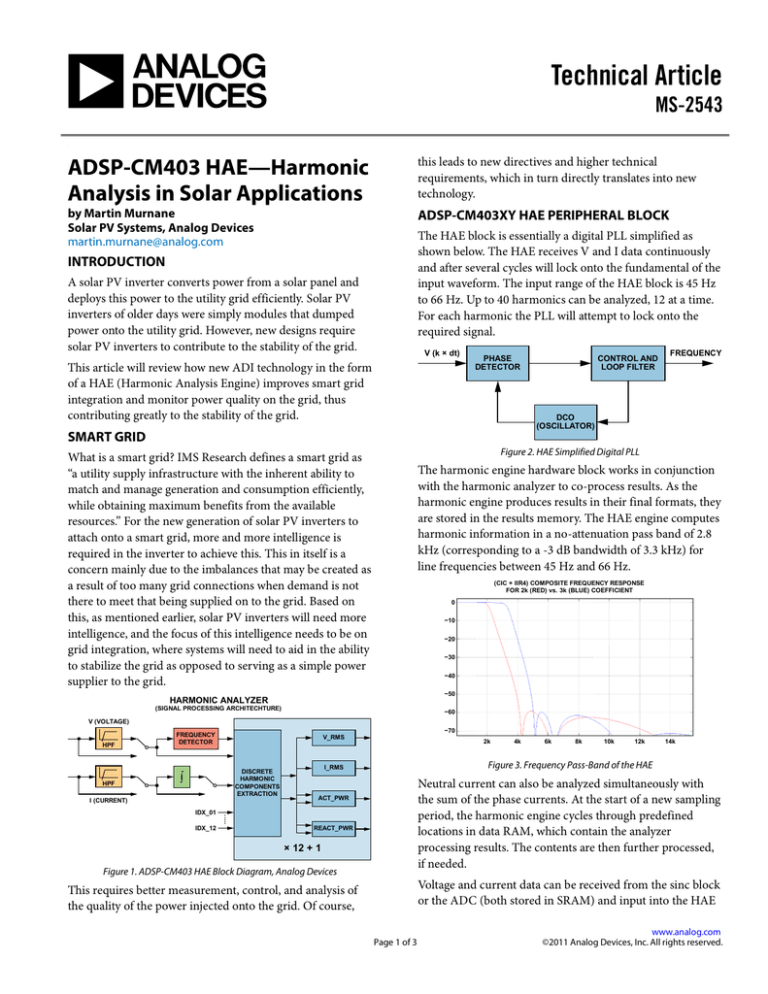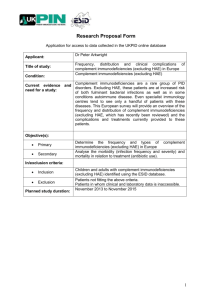Technical Article ADSP-CM403 HAE—Harmonic MS-2543
advertisement

Technical Article
MS-2543
.
ADSP-CM403 HAE—Harmonic
Analysis in Solar Applications
this leads to new directives and higher technical
requirements, which in turn directly translates into new
technology.
by Martin Murnane
Solar PV Systems, Analog Devices
martin.murnane@analog.com
ADSP-CM403XY HAE PERIPHERAL BLOCK
The HAE block is essentially a digital PLL simplified as
shown below. The HAE receives V and I data continuously
and after several cycles will lock onto the fundamental of the
input waveform. The input range of the HAE block is 45 Hz
to 66 Hz. Up to 40 harmonics can be analyzed, 12 at a time.
For each harmonic the PLL will attempt to lock onto the
required signal.
INTRODUCTION
A solar PV inverter converts power from a solar panel and
deploys this power to the utility grid efficiently. Solar PV
inverters of older days were simply modules that dumped
power onto the utility grid. However, new designs require
solar PV inverters to contribute to the stability of the grid.
V (k × dt)
This article will review how new ADI technology in the form
of a HAE (Harmonic Analysis Engine) improves smart grid
integration and monitor power quality on the grid, thus
contributing greatly to the stability of the grid.
PHASE
DETECTOR
CONTROL AND
LOOP FILTER
FREQUENCY
DCO
(OSCILLATOR)
SMART GRID
Figure 2. HAE Simplified Digital PLL
What is a smart grid? IMS Research defines a smart grid as
“a utility supply infrastructure with the inherent ability to
match and manage generation and consumption efficiently,
while obtaining maximum benefits from the available
resources.” For the new generation of solar PV inverters to
attach onto a smart grid, more and more intelligence is
required in the inverter to achieve this. This in itself is a
concern mainly due to the imbalances that may be created as
a result of too many grid connections when demand is not
there to meet that being supplied on to the grid. Based on
this, as mentioned earlier, solar PV inverters will need more
intelligence, and the focus of this intelligence needs to be on
grid integration, where systems will need to aid in the ability
to stabilize the grid as opposed to serving as a simple power
supplier to the grid.
The harmonic engine hardware block works in conjunction
with the harmonic analyzer to co-process results. As the
harmonic engine produces results in their final formats, they
are stored in the results memory. The HAE engine computes
harmonic information in a no-attenuation pass band of 2.8
kHz (corresponding to a -3 dB bandwidth of 3.3 kHz) for
line frequencies between 45 Hz and 66 Hz.
(CIC + IIR4) COMPOSITE FREQUENCY RESPONSE
FOR 2k (RED) vs. 3k (BLUE) COEFFICIENT
0
−10
−20
−30
−40
−50
HARMONIC ANALYZER
(SIGNAL PROCESSING ARCHITECHTURE)
−60
V (VOLTAGE)
HPF
FREQUENCY
DETECTOR
DISCRETE
DISCRETE
HARMONIC
HARMONIC
COMPONENTS
COMPONENTS
EXTRACTION
EXTRACTION
HPF
IDX_12
2k
4k
6k
8k
10k
12k
14k
Figure 3. Frequency Pass-Band of the HAE
I_RMS
Neutral current can also be analyzed simultaneously with
the sum of the phase currents. At the start of a new sampling
period, the harmonic engine cycles through predefined
locations in data RAM, which contain the analyzer
processing results. The contents are then further processed,
if needed.
ACT_PWR
.....
I (CURRENT)
IDX_01
−70
V_RMS
REACT_PWR
× 12 + 1
Figure 1. ADSP-CM403 HAE Block Diagram, Analog Devices
Voltage and current data can be received from the sinc block
or the ADC (both stored in SRAM) and input into the HAE
This requires better measurement, control, and analysis of
the quality of the power injected onto the grid. Of course,
Page 1 of 3
www.analog.com
©2011 Analog Devices, Inc. All rights reserved.
MS-2543
Technical Article
block at an 8 kHz rate. An interrupt can be generated at this
8 kHz rate to advise the solar PV inverter to input available
data. When the data is analyzed and those calculations below
are computed, the HAE block will generate another interrupt
to advise the solar PV system that the harmonic analysis
data is ready for display. The ADSP-CM403 can also direct
the HAE to DMA all results to SRAM where the system code
can then display the results. This results in little code
overhead for the entire HAE system.
Figure 4. V rms Sample Results from the HAE for Harmonics 1–12
ADSP-CM403XY HAE RESULTS
The specific equations used in these calculations are shown
below, for both fundamental and harmonic calculations.
The HAE results in Figure 4 show clearly which harmonics
are present in the system when looking at the voltage rms
data. The fundamental at 50 Hz is clearly present, however
the lower harmonics at 250 Hz and 350 Hz (i.e. harmonics 5
and 7) have some presence in this example result set.
RESOURCES
Share this article on
Table 1. HAE Mathematical Calculations
Page 2 of 3
Technical Article
MS-2543
PROGRAMMING EXAMPLE
INT HAE_CONFIG(VOID)
{ INT I;
HAE_INPUT_DATA(VOUTPUT, SINC_VEXT_DATA);
HAE_INPUT_DATA(IOUTPUT, SINC_IMEAS_DATA);
RESULT = ADI_HAE_OPEN(DEVNUM, DEVMEMORY, MEMORY_SIZE, &DEV);
RESULT = ADI_HAE_REGISTERCALLBACK(DEV, HAECALLBACK, 0);
RESULT = ADI_HAE_SELECTLINEFREQ(DEV, ADI_HAE_LINE_FREQ_50);
RESULT = ADI_HAE_CONFIGRESULTS(DEV, ADI_HAE_RESULT_MODE_IMMEDIATE, ADI_HAE_SETTLE_TIME_512,
ADI_HAE_UPDATE_RATE_128000);
RESULT = ADI_HAE_SETVOLTAGELEVEL (DEV, 1.0);
RESULT = ADI_HAE_ENABLEINPUTPROCESSING(DEV, FALSE, FALSE); /* FILTER ENABLED */
/* ENABLE ALL HARMONICS (IN ORDER) */
RESULT = ADI_HAE_HARMONICINDEX (DEV, ADI_HAE_HARMONIC_INDEX_1, 1);
RESULT = ADI_HAE_HARMONICINDEX (DEV, ADI_HAE_HARMONIC_INDEX_2, 2);
RESULT = ADI_HAE_HARMONICINDEX (DEV, ADI_HAE_HARMONIC_INDEX_3, 3);
RESULT = ADI_HAE_HARMONICINDEX (DEV, ADI_HAE_HARMONIC_INDEX_4, 4);
RESULT = ADI_HAE_HARMONICINDEX (DEV, ADI_HAE_HARMONIC_INDEX_5, 5);
RESULT = ADI_HAE_HARMONICINDEX (DEV, ADI_HAE_HARMONIC_INDEX_6, 6);
RESULT = ADI_HAE_HARMONICINDEX (DEV, ADI_HAE_HARMONIC_INDEX_7, 7);
RESULT = ADI_HAE_HARMONICINDEX (DEV, ADI_HAE_HARMONIC_INDEX_8, 8);
RESULT = ADI_HAE_HARMONICINDEX (DEV, ADI_HAE_HARMONIC_INDEX_9, 9);
RESULT = ADI_HAE_HARMONICINDEX (DEV, ADI_HAE_HARMONIC_INDEX_10, 10);
RESULT = ADI_HAE_HARMONICINDEX (DEV, ADI_HAE_HARMONIC_INDEX_11, 11);
RESULT = ADI_HAE_HARMONICINDEX (DEV, ADI_HAE_HARMONIC_INDEX_12, 12);
RESULT = ADI_HAE_SUBMITTXBUFFER(DEV, &TXBUFFER1[0], SIZEOF(TXBUFFER1));
RESULT = ADI_HAE_SUBMITTXBUFFER(DEV, &TXBUFFER2[0], SIZEOF(TXBUFFER2));
RESULT = ADI_HAE_ENABLEINTERRUPT(DEV, ADI_HAE_INT_RX, TRUE);
RESULT = ADI_HAE_ENABLEINTERRUPT(DEV, ADI_HAE_INT_TX, TRUE);
RESULT = ADI_HAE_CONFIGSAMPLEDIVIDER(DEV, 100000000);
RESULT = ADI_HAE_RUN(DEV, TRUE);
// RESULT = ADI_HAE_CLOSE(DEV);
}
/* EVENTS */
VOID HAECALLBACK(VOID* PHANDLE, UINT32_T EVENT, VOID* PARG)
/* ISR ROUTINE TO LOAD / UNLOAD DATA FROM HAE
{
UINT32_T N;
ADI_HAE_EVENT EEVENT = (ADI_HAE_EVENT)EVENT;
/* RESULTS RECEIVED FROM HAE 128MS */
IF (EEVENT == ADI_HAE_EVENT_RESULTS_READY)
{
/* GET RESULTS */
PRESULTS = (ADI_HAE_RESULT_STRUCT*)PARG;
/* POINTER TO TXBUFFER1 OR TXBUFFER2 */
/* DO SOMETHING WITH THE RESULTS */
FOR (N=0; N<NUM_CHANNELS; N++)
{
IRMS[N] = PRESULTS[N].IRMS;
VRMS[N] = PRESULTS[N].VRMS;
ACTIVEPWR[N] = PRESULTS[N].ACTIVEPWR;
}
}
/* TRANSMIT INPUT SAMPLES TO HAE – 8KHZ */
IF (EEVENT == ADI_HAE_EVENT_INPUT_SAMPLE)
{
/* FIND LATETS SAMPLES FROM SINC BUFFER . */
ADI_HAE_INPUTSAMPLE(DEV, (SINC_IMEAS_DATA[PWM_SINC_LOOP]), (SINC_VEXT_DATA[PWM_SINC_LOOP]));
INDEX++;
IF (INDEX >= NUM_SAMPLES) INDEX = 0;
}
COUNT++;
}
One Technology Way • P.O. Box 9106 • Norwood, MA 02062-9106, U.S.A.
Tel: 781.329.4700 • Fax: 781.461.3113 • www.analog.com
Trademarks and registered trademarks are the property of
their respective owners.
TA11824-0-9/13
www.analog.com
©2011 Analog Devices, Inc. All rights reserved.
Page 3 of 3





